The Levant Sparrowhawk (Accipiter brevipes) is a captivating raptor species endemic to the Middle East, specifically the Levant region, encompassing countries such as Lebanon, Israel, Jordan, and Syria.
Characterized by its sleek and compact build, this bird of prey is renowned for its agility and swift flight, making it a formidable hunter in diverse landscapes ranging from woodlands to open areas.
With a distinctive plumage that varies between males and females, the Levant Sparrowhawk exhibits sexual dimorphism, adding to its allure for bird enthusiasts and ornithologists alike.
Despite its local distribution, the species faces conservation concerns due to habitat loss and human-related threats, underscoring the importance of ongoing efforts to protect and preserve this emblematic raptor.
Studying the Levant Sparrowhawk provides valuable insights into the ecological dynamics of the region and highlights the significance of biodiversity conservation in maintaining the delicate balance of ecosystems in the Levant.
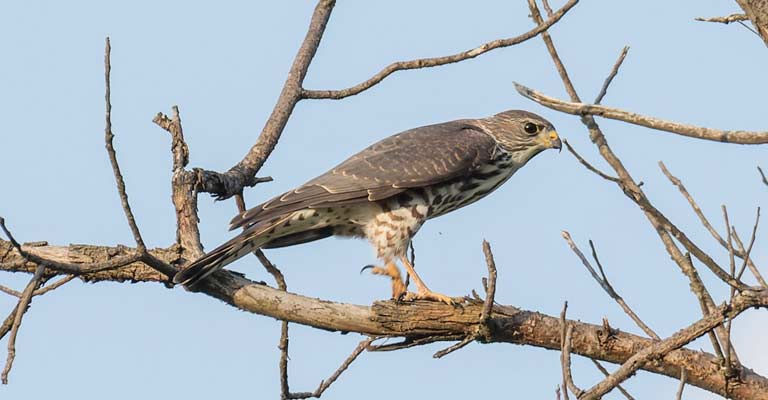
Physical Characteristics of Levant Sparrowhawk
The Levant Sparrowhawk (Accipiter brevipes) is a distinctive bird of prey with several physical characteristics that aid in its identification.
While some features may vary between males and females, the following points encompass the general characteristics that help distinguish the Levant Sparrowhawk from other raptors:
Size and Build
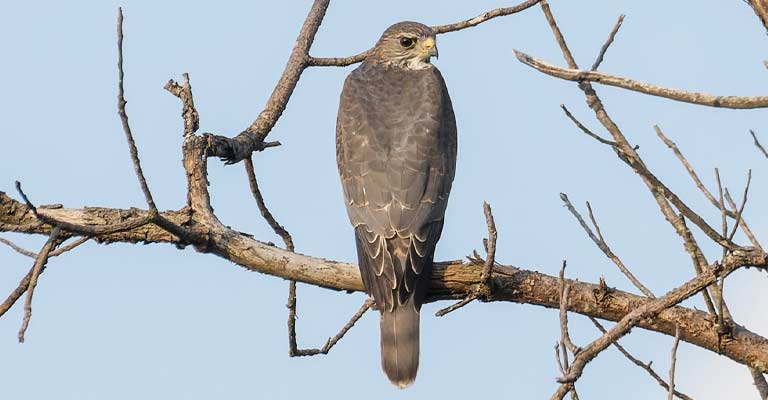
The Levant Sparrowhawk is a compact and medium-sized raptor, typically measuring around 30 to 35 centimeters in length.
Its streamlined and robust build contributes to its agility in flight, allowing it to navigate through dense vegetation during hunting.
Plumage
Adult male and female Levant Sparrowhawks exhibit noticeable differences in plumage. Adult males often showcase a bluish-gray upper body with a contrasting reddish-brown barred underbelly.
In contrast, adult females display a brownish-gray upper body and a streaked underbelly, aiding in sexual dimorphism.
Tail and Wing Features
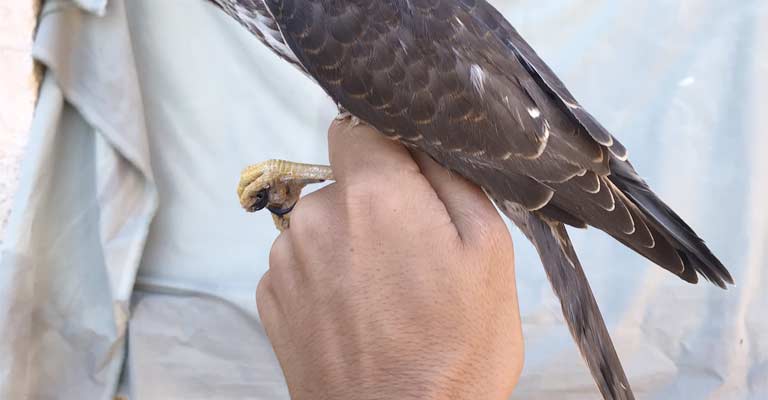
The tail of the Levant Sparrowhawk is relatively long and squared-off, a characteristic that sets it apart from other raptors.
Additionally, the wings are short and rounded, facilitating quick and precise maneuvers while hunting in confined spaces.
Facial Markings
The facial markings of the Levant Sparrowhawk include a distinctive white eyebrow or supercilium that contrasts with its dark eye.
This feature adds a striking element to its appearance, aiding observers in identifying the bird in the field.
Yellow Cere and Legs
The cere, a fleshy covering at the base of the beak, is yellow, providing a notable contrast to the bird’s facial features.
Similarly, the legs of the Levant Sparrowhawk are yellow, a characteristic that can be observed when the bird is perched or during close-range observations.
Flight Pattern
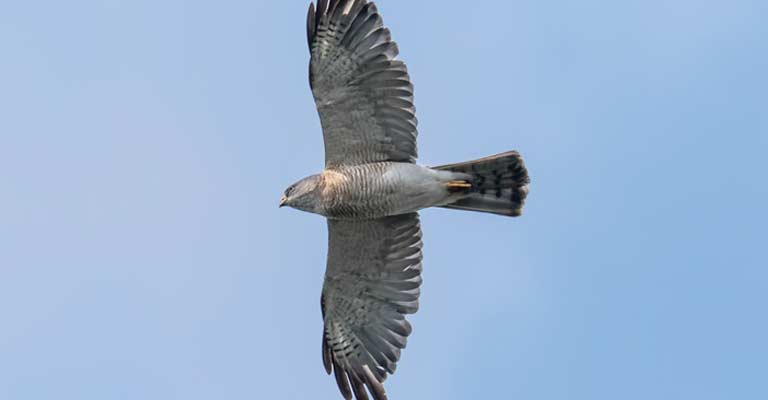
In flight, the Levant Sparrowhawk exhibits a series of rapid wing beats followed by a gliding motion. Its distinctive flight pattern, combined with its short and rounded wings, aids in distinguishing it from other raptors in the region.
Juvenile Characteristics
Juvenile Levant Sparrowhawks have a more mottled appearance with brown and buff colors.
As they mature, their plumage gradually transforms into distinct adult coloring, making age-related features an essential aspect of identification.
Habitat and Geographic Range
Observing the Levant Sparrowhawk in its natural habitat provides additional clues for identification.
The bird is typically found in wooded areas, shrublands, and open habitats within the Levant region, offering context to its presence in a specific geographic range.
By combining these key physical characteristics, birdwatchers and researchers can confidently identify the Levant Sparrowhawk, contributing to a better understanding of its behavior, ecology, and conservation needs.
Taxonomy of Levant Sparrowhawk
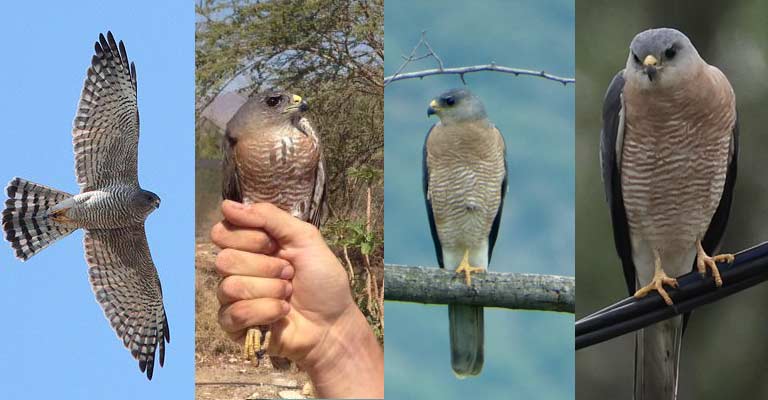
Here is a table outlining the taxonomy details of the Levant Sparrowhawk (Accipiter brevipes):
| Taxonomic Rank | Classification |
| Domain | Eukaryota |
| Kingdom | Animalia |
| Phylum | Chordata |
| Class | Aves |
| Order | Accipitriformes |
| Family | Accipitridae |
| Genus | Accipiter |
| Species | A. brevipes |
The Levant Sparrowhawk (Accipiter brevipes) belongs to the domain Eukaryota, the kingdom Animalia, and the phylum Chordata.
As a bird, it falls under the class Aves and the order Accipitriformes. Its family is Accipitridae, and it is specifically classified under the genus Accipiter. The species designation is A. brevipes.
This compact raptor’s taxonomy reflects its place within the diverse avian landscape, emphasizing its relation to other birds of prey while providing a systematic framework for understanding its biological classification within the broader animal kingdom.
Levant Sparrowhawk Life History
The life history of the Levant Sparrowhawk (Accipiter brevipes) unveils a fascinating narrative of survival and adaptation in the diverse landscapes of the Middle East.
From its dietary habits and nesting behaviors to breeding patterns and conservation challenges, each aspect provides insight into the intricacies of this bird’s existence.
Food
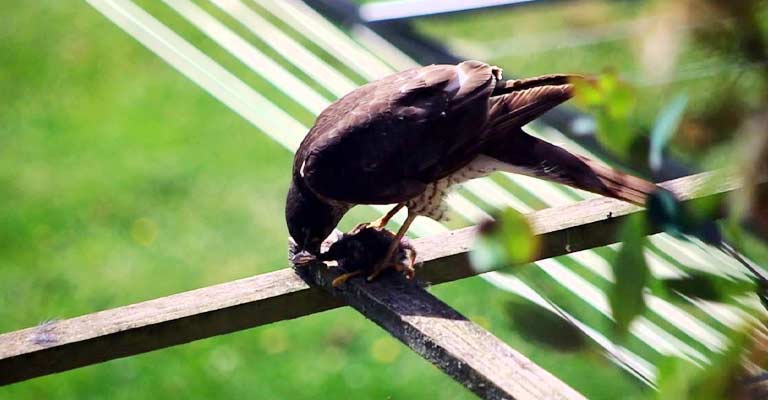
The Levant Sparrowhawk is a carnivorous bird of prey, primarily feeding on small birds and insects.
Its diet includes sparrows, finches, and other songbirds, showcasing a remarkable hunting ability characterized by swift flights and precise strikes.
Habitat
This raptor thrives in a variety of habitats, ranging from woodlands and shrublands to open areas.
Its adaptability to diverse environments within the Levant region underscores its resilience and ability to exploit different niches for foraging and breeding.
Range Map
The Levant Sparrowhawk’s range map encompasses the Levant region, covering countries such as Lebanon, Israel, Jordan, and Syria.
The species’ distribution is influenced by the availability of suitable habitats and prey, contributing to its localized presence.
Nesting

Nesting is a crucial aspect of the Levant Sparrowhawk’s life history. These birds construct compact nests in tree canopies, often using twigs and branches.
The strategic placement of nests enhances their concealment, providing a secure environment for raising offspring.
| Nesting Details | Facts |
| Clutch Size | 3 to 4 eggs |
| Number of Broods | Typically 1 per breeding season |
| Egg Length | Approximately 40-50 mm |
| Egg Width | Around 30-35 mm |
| Incubation Period | Approximately 28-32 days |
| Nestling Period | About 20-25 days |
| Egg Description | Pale blue-green or white with blotchy markings |
| Nest Type | Compact nest made of twigs and branches |
| Nest Placement | High in tree canopies for concealment |
| Parental Care | Both parents participate in incubation and care |
Breeding
Breeding occurs during the spring and early summer months. The female lays a clutch of eggs, and both parents share responsibilities during incubation.
Upon hatching, the chicks are fed by both parents until they fledge, marking the beginning of their independent journey.
Diseases
Like many avian species, the Levant Sparrowhawk is susceptible to diseases. Avian malaria and other infectious agents pose potential threats, impacting the health and reproductive success of individuals within the population.
Treatment
Conservation efforts include monitoring and addressing diseases through research and veterinary interventions.
Initiatives such as captive breeding programs and habitat restoration contribute to the overall health and resilience of the Levant Sparrowhawk population.
Conservation
The Levant Sparrowhawk faces conservation challenges due to habitat loss, climate change, and human activities.
Conservation strategies involve habitat preservation, community engagement, and international collaboration to ensure the sustained protection of this iconic raptor.
In essence, the life history of the Levant Sparrowhawk is a dynamic interplay of ecological interactions, reproductive strategies, and conservation imperatives, emphasizing the need for holistic approaches to safeguard its presence in the intricate ecosystems of the Levant.
10 Fun Facts About Levant Sparrowhawk
The Levant Sparrowhawk (Accipiter brevipes) is a captivating bird of prey that not only plays a crucial role in maintaining ecological balance but also boasts several intriguing features.
Here are 10 fun facts that shed light on the unique characteristics and behaviors of this remarkable raptor.
- Master of Stealth: Known for its exceptional agility and stealthy hunting techniques, the Levant Sparrowhawk can navigate through dense vegetation with remarkable ease, surprising its prey with swift and precise attacks.
- Distinctive Plumage: Adult males showcase a striking bluish-gray upper body with a reddish-brown barred underbelly, while adult females exhibit a brownish-gray upper body with a streaked underbelly, making them easily distinguishable.
- Tailor-Made for Flight: The Levant Sparrowhawk’s short and rounded wings, coupled with a long squared-off tail, contribute to its remarkable flight abilities. These adaptations allow it to swiftly maneuver through various landscapes during hunting.
- Superior Hunting Skills: Specializing in hunting small birds and insects, the Levant Sparrowhawk employs a sit-and-wait strategy, perching inconspicuously before launching into rapid flight to capture its prey.
- Breeding Ballet: During the breeding season, the male Levant Sparrowhawk engages in an elaborate courtship display, showcasing aerial acrobatics to attract a mate. This intricate ballet serves as a testament to the species’ dedication to reproductive success.
- Nomadic Wanderer: The Levant Sparrowhawk is known for its nomadic tendencies, often making seasonal movements in response to the availability of prey and favorable environmental conditions.
- Eggs of Beauty: The pale blue-green or white eggs of the Levant Sparrowhawk are adorned with blotchy markings, adding a touch of artistry to the nesting process.
- Doting Parenthood: Both male and female Levant Sparrowhawks actively participate in incubating the eggs and caring for the nestlings, showcasing a strong sense of parental dedication.
- Migratory Marvel: Some populations of Levant Sparrowhawks undertake seasonal migrations, covering impressive distances to ensure access to suitable breeding and feeding grounds.
- Conservation Concerns: Despite its adaptability, the Levant Sparrowhawk faces conservation challenges due to habitat loss and human-related threats, emphasizing the need for concerted efforts to protect and preserve this charismatic bird.
These fun facts offer a glimpse into the captivating world of the Levant Sparrowhawk, highlighting its prowess as a hunter, its distinctive appearance, and the various aspects that make it a fascinating subject of study and admiration in the avian realm.
Wrapping Up
The Levant Sparrowhawk (Accipiter brevipes) emerges as a captivating and resilient bird of prey, weaving its story through the diverse landscapes of the Middle East.
From its distinctive plumage and agile flight to its intricate courtship displays and active parental care, this raptor stands as a testament to the marvels of avian adaptation.
While its nomadic tendencies and seasonal migrations showcase a dynamic response to environmental changes, the Levant Sparrowhawk faces conservation challenges, underscoring the delicate balance between human activities and wildlife preservation.
As we marvel at its beauty and appreciate its ecological role, it becomes imperative to channel efforts into safeguarding its habitats and addressing threats to ensure the continued existence of this iconic species.
The Levant Sparrowhawk, with its graceful presence and ecological significance, beckons us to delve deeper into the realms of conservation, where our collective actions can secure a harmonious future for both this remarkable bird and the delicate ecosystems it inhabits.